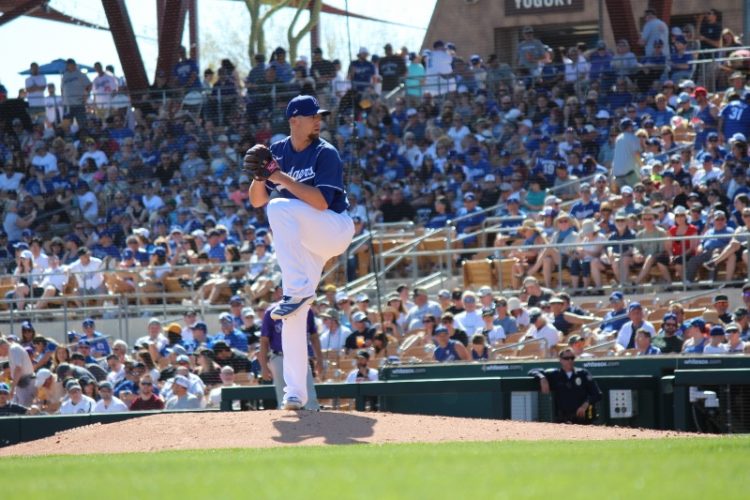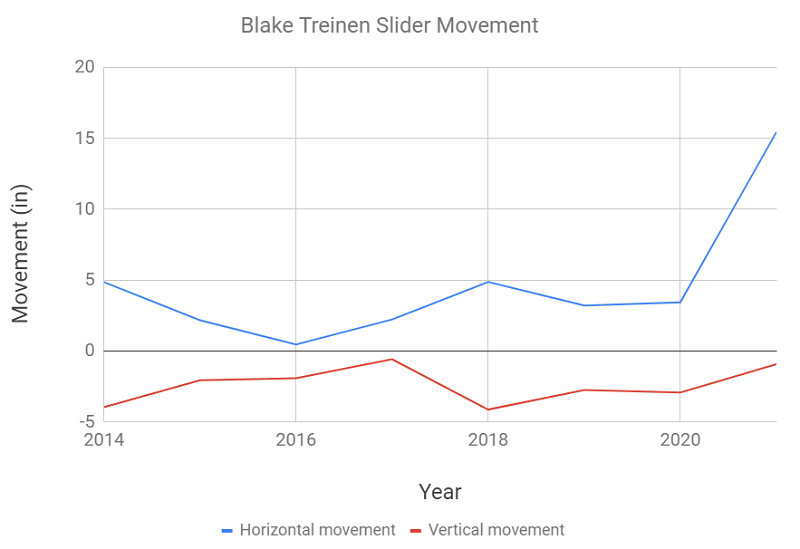
Writing an analytically-tilted baseball article this time of season is extremely difficult. Doubly so when it’s about a relief pitcher. Samples are too small to mean much, and this season things are complicated by the fact that there’s a new baseball. This particular article is about a sample size of five pitches. So instead of pretending that there’s a deep conclusion to be drawn here, this article is definitely more of the “hey, look at this” variety.
——
Over the years, Blake Treinen has developed the reputation of being primarily a sinker-oriented pitcher, though that has been changing for the past few seasons. In 2020, Treinen threw his sinker about 55% of the time and relied on his cutter and slider to cover most of the rest (with occasional four-seams mixed in). Through most of Treinen’s career, his slider has been about 5 mph slower than his cutter, with very similar horizontal movement and about five inches more drop.
However, so far in this extremely young season, Treinen’s repertoire seems to be changing. On Tuesday night, he struck out two members of his former team, both on the same nasty-looking pitch:
As Twitter follower @jamesdakrn pointed out, the movement data of the pitch is very different this season:

For a more visual comparison, here is Treinen’s slider from two years ago from in front of the same camera:
In the older video, Treinen’s slider movement is almost completely vertical. It relied on the difference in horizontal break compared to the two-seam or the change of pace and slight dip compared to the cutter in order to get swings and misses or weak contact. Now the pitch sweeps across the plate much more dramatically. The pitch is about 1 mph slower than its average speed last season, giving it about 1.5 mph more velocity separation from his sinker and about the same amount of velocity separation from the cutter.
Interestingly, Treinen’s new slider does not seem to be the result of any change in the underlying spin rate of the pitch, which is almost identical to last season. The difference in movement seems to be caused by a mechanical tweak, perhaps a grip change. Additionally, the pitch’s different look does not seem related to the difference in ball, as Baseball Savant’s comparison to average pitch movement shows a major shift this season:

This new pitch has a pretty unusual origin, too. Treinen threw the bigger, more sweeping version of his slider for the first time in game four of the World Series. What a time to try something new. More specifically, Treinen used the tweaked pitch to attack the unstoppable Randy Arozarena:
In that plate appearance, Treinen’s four sliders had 15, 13, 14, and 17 inches of horizontal movement. The maximum horizontal movement of any other slider he threw in the playoffs was 7 inches and each slider broke more horizontally than any other he threw in 2020. However, the new look slider didn’t actually work in this plate appearance; Treinen left the 17 inch breaker over the heart of the plate and Arozarena lined it up the middle, because of course he did.
Even more interesting is that later in the same outing, Treinen threw two sliders against Austin Meadows, striking him out with the more downward-breaking variant. This shows that Treinen may actually have two different sliders that he can switch between rather than one tweaked pitch.
——
Is this a good thing? It seems like it on paper (and on the field so far), but this early in the season we need to be careful drawing conclusions.
Will Treinen command the new slider better than the old one? Was the closer movement to the cutter more deceptive? Is this new slider one pitch or two pitches? Will this version of the slider get hit harder if it is left in the zone? These are the types of questions which are hard to answer this early in the season. However, it’s nice to have something that has been identified as new and interesting this early on, and it will be fun to watch the development of the pitch going forward.
 Dodgers Digest Los Angeles Dodgers Baseball Blog
Dodgers Digest Los Angeles Dodgers Baseball Blog